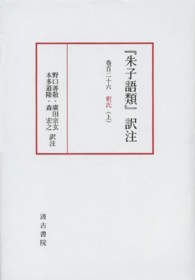Full Description
This book aims to determine UNESCO's capability to facilitate heritage protection measures pre-conflict, emergency response measures during conflict and reconstruction efforts post-conflict. The book employs document analysis to ascertain UNESCO's legal obligations when it comes to facilitating cultural heritage protection in its Member States' territories in the condition of armed conflict, while drawing comparisons with the reality of the organisation's presence and involvement in Yemen, Syria and Iraq. This study maps shifts in UNESCO's level of communication with each country's respective government and civil authorities; allocation of financial, human and material resources; and implementation of heritage safeguarding and reconstruction initiatives. Both quantitative and qualitative data shows UNESCO to exhibit great inequity in engagement, at times, closing communications entirely with Syria, due to the political standpoints of other UNESCO Member States. This politicalgridlock is often shown to result in the organisation overstating its ability to safeguard or restore heritage, with promises not being followed up with action. Since 2015, UNESCO has expressed a stronger intent to be a key player in heritage protection during armed conflict, however as long as cultural heritage protection is not considered a humanitarian concern, UNESCO will not be able to circumvent much of the political and bureaucratic barriers facing intergovernmental organisations during conflict, which prevent emergency action from being implemented. In order to ensure heritage safeguarding is permitted during periods of significant unrest, regardless of political discord, it is crucial that UNESCO promote a people-centred approach to its cultural heritage protection initiatives. This book evidences that focusing on livelihoods and meaningful and practical connections between populations and their local heritage to be UNESCO's optimal methodological approach forjustifying cultural heritage protection as a humanitarian necessity. The book's readership includes academics, researchers, and practitioners in the fields of political science, law and heritage studies.
Contents
Chapter 1: Where Conflict and Culture Connect.- Chapter 2: UNESCO's Legal Obligation and Capability to Protect Cultural Heritage during Armed Conflict .- Chapter 3: The State Heritage Institutions of Yemen, Syria and Iraq.- Chapter 4: The Impact of Conflict on UNESCO's Engagement with Yemen, Syria and Iraq.- Chapter 5: UNESCO's Emergency Response "First-Aid" to Cultural Heritage Sites.- Chapter 6: UNESCO's Reconstruction of Cultural Heritage Sites.- Chapter 7: Conclusions.- References.- Appendices.








